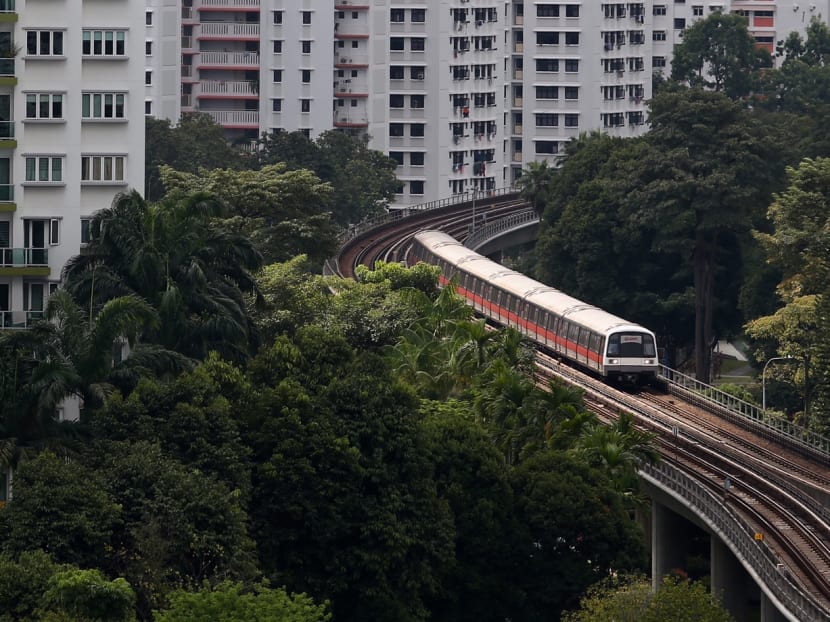S$900 million North-South, East-West MRT line power supply project to be completed by 2023
SINGAPORE – An extensive project to renew the power supply system of the North-South and East-West MRT lines will cost nearly S$900 million and take five years to complete after work begins later this year, said Transport Minister Khaw Boon Wan on Friday (May 11).

A project to renew the power supply of the North-South, East-West MRT line power supply project will cost S$900 million and is scheduled to be completed by 2023.
SINGAPORE – An extensive project to renew the power supply system of the North-South and East-West MRT lines will cost nearly S$900 million and take five years to complete after work begins later this year, said Transport Minister Khaw Boon Wan on Friday (May 11).
If necessary, the authorities and train operator will extend engineering hours to complete the power system renewal more quickly, said Mr Khaw in his speech at the sixth Joint Forum on Infrastructure Maintenance.
The “extensive and complex” project will replace nearly 1,300km of power cables and 250km of fibre optics cables, as well as several power transformers, switchboards and substations.
While the team has already started on the design and planning for the project, the minister said it is a “laborious task” that cannot be rushed.
Mr Khaw said: “Many things can go wrong if we are not careful. If the renewal is not well-executed, it can have a widespread impact on passenger service. It’s as simple as that – No power, no train (service).”
The Land Transport Authority (LTA) announced in February that three contracts were awarded to upgrade and renew the power supply and track circuit systems on the North-South and East-West Lines (NSEWL). Two contracts were awarded to Meiden Singapore to upgrade and renew the NSEWL power supply system, while the third was awarded to a consortium comprising Siemens and ENGIE Services Singapore to replace the NSEWL track circuit system.
Given the high voltage working environment, the transport authorities and operator will take every precaution to ensure the project is implemented smoothly and safely.
The temporary mobile substations must be set up before the existing power supply equipment can be removed. The new power supply system can then be installed and reconfigured after that, among other steps.
All these tasks must be completed satisfactorily before passenger service resumes the next morning, which is why early closures and late openings are so “valuable”, added Mr Khaw.
Since certain MRT lines have begun implementing earlier closing and later opening hours, it has provided the engineers and maintenance crew with extended engineering hours to do their job properly, which is essential for ageing MRT lines, he said.
“There is no shortcut to comprehensive maintenance. This is especially critical as we step up renewal of ageing assets, like the signaling system,” he added.
While extensive shuttle services and early announcements can minimise the inconvenience to commuters, Mr Khaw acknowledged that commuters are still affected by the trains’ shorter operating hours.
“Our response is to make full use of the extended engineering hours to improve train reliability. We owe it to our commuters,” he said.
The early closures and late openings have produced results, said Mr Khaw, as he cited how the rail system is on track to achieve its one million train-km goal, measured as mean kilometres between failure (MKBF), before 2020.
In addition, they managed to speed up the resignalling of the East-West Line. Previous tests have been uneventful, and Mr Khaw said he is optimistic that the operator can conduct full live tests every day during the June school holidays.
He also launched the Minister for Transport Challenge Shield to remind everyone in the transport sector why rail reliability has to be prioritised, and “never to neglect it again going forward”.
The selection will be based on the MKBF each MRT line achieves during each calendar year, and winners of the most reliable MRT line and most improved MRT line will receive a modest cash prize to be used to improve staff welfare as appreciation of the engineering and maintenance crew.
Between January and April, the Downtown Line exceeded the MKBF of one million train-km. In the first quarter of the year, the Circle Line and North-East Line also exceeded the MKBF of one million train-km, while the North-South Line improved by more than 500,000 train-km.
Mr Khaw added: “We are in the process of stabilising (rail reliability), restoring it, regaining public trust and we will get there. But once we get there, it doesn’t mean mission accomplished… It is continuous attention and focus on this area.”






